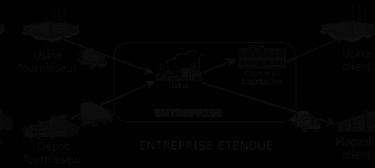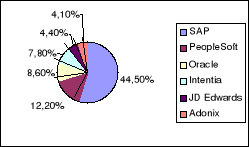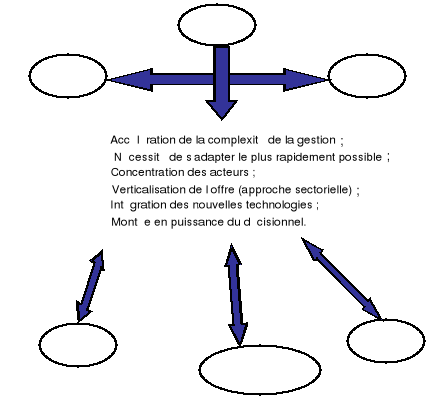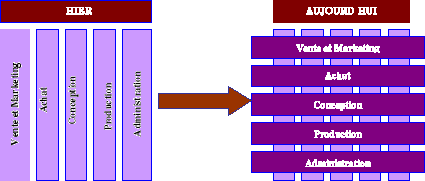
Publier un mémoire
Consulter les autres mémoires

|
Publier un mémoire Consulter les autres mémoires |
|
|
The ERP which can be translated by «Resource requirements planning of L 'Undertaken » is theoretically art to manage, in an optimized way, the means and resources available to a company thanks to an integrated software package of management.
The term of Software package is a neologism creates in 1962 by J.E.Forges, starting from the produced words and software.
Several authors covered the subject such as Casino which according to him the ERP «Is an integrated software whose various modules make it possible to treat the whole of functions (finance, production, sales, accountancy, human resources, etc) of the company » like Jean-Louis Lequeux, in his work «Manager ERP », which defines ERP as «A subset of the information system in charge of the integral management of the company ».
The ERP is an integrated software package constituted of functional modules and opened tools of modeling, structured around a system of relational data bases ensuring a single, coherent, made safe and opened management data of the company while allowing the modeling of the whole of the processes of the company, which they are operational or process of support.
These modules cover :
· Production control ;
· The management of the purchases and stocks ;
· Administration of the sales;
· Countable and financial management ;
· The control of management.
It is a software package skeletal allowing to reconcile standardization and adaptation to the company. It is opposed to the software owner developed for the specific needs for the company. It is a solution of international size able to manage in a way integrated of the contexts of multi-legislations and multi-languages.
Management in mode ERP aims to manage and plan the whole of flows and the functions of a company, including logistic flows. The field of application extends from the chain supplier to the final customers. One can thus speak about WIDE COMPANY.

Figure 6 : The wide company
On the market of the ERP, one finds several editors of software package, but most known whose SAP, JDEdwards, Oracle, Peoplesoft control more than 65% of the market. The graph below presents as an indication the Share of market of the editors of ERP in France during the year 2002.

Figure 7 : Actors of the market (source CAP)
During a press conference held in New York on September 5, 2003, Craig Conway, president of the executive committee of Peoplesoft, announces fusion between J.D. Edwards and Peoplesoft. The product carrying mark J.D. Edwards is not marketed any more.
Each company has various reasons to establish a software package of management integrated in its organization. However, these reasons can be indexed according to two large axes: external constraints and internal stresses.
The external constraints are simple releases of the establishment and not of the reasons related to the specific activities of the company. The principal external constraints are the passage to the year 2000, the passage to the Euro and the globalisation.

Figure 8 : Reasons of establishment of a ERP
These three reasons involve, indeed, an important cost of adaptation of the existing data-processing software in the companies. These last benefit from this occasion to establish a more complex information system.
The technological projection and competition also represent external constraints for the companies, since they imply that the company must be held up to date last evolutions in the data-processing field so that its information system is not exceeded.
The internal stresses involve as for them a need for tools which imply a great flexibility of evolution, a hyper reactivity with the change and a capacity of almost unbounded adaptation, and this at a tiny cost.
The two great types of internal stresses of an organization are on the one hand the strategic changes of the company and on the other hand competitiveness and the productivity.
The strategic changes of an organization get along on several levels :
· The international level : the company aims at a management by process and activities and either by functions and costs. The company must moreover gain in speed and flexibility. The solution of the integrated software package makes it possible to the leaders to have a homogeneous vision of all their operations throughout the world.
· The level of the reorganization and the reorganization of the company : the information systems must be an engine in the permanent structural changes which the company knows. The integrated software packages of management make it possible to harmonize the way of working of the various sites of the company.
· The level cost: The integrated software packages of management are often more economic than the internal developments. It is one of the imperative reasons of their strong current growth.
The second type of internal stress relates to the competitiveness and the productivity of the company.
The competitiveness of a company lies in its capacity to revise, reinvent and automate the whole of its processes and in its capacity to reduce its cycles. The key words are thus quality, flexibility, speed, cost, service, traceability and reactivity. The result is immediately a better customer service.
The companies thus need flexible, evolutionary data-processing solutions to meet the needs changing for the market but also for a complete integration of the functions of management to react to the market.
However, various problems exist. For example, traditional data processing is unable to answer in an adequate way the requirement of growth imposed by the market.
The solution is thus to create processes which cross the activities of the company and which this one adopts a horizontal structure.

Figure 9 : Evolution of the structure of activity of the company
The integrated software packages of management take into account the new needs for the companies, i.e. their request of more than information, more division, more integration and more flexibility.